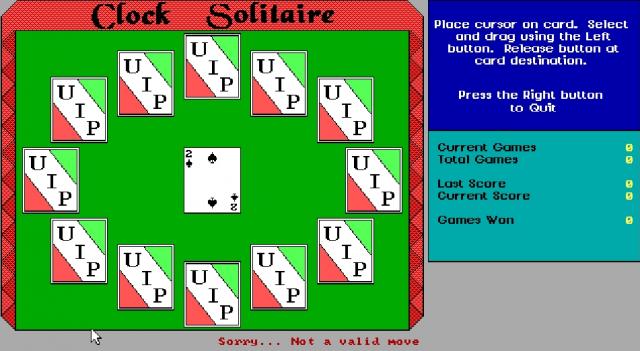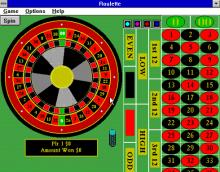Clock Solitaire
How to play Clock Solitaire
- Deal Cards: Start by dealing 13 piles, with 4 cards each, placed in a circle like a clock.
- Move Cards: Begin with the central pile, moving the top card to the corresponding clock position (Ace to 1, 2 to 2, etc.).
- Reveal Cards: Each card moved reveals another card from the same pile, which is then placed in its appropriate position.
- Win Condition: Continue moving cards until all cards are in their correct positions or no more moves are possible.
Clock Solitaire Description
Clock Solitaire is a timeless card game that challenges your strategic thinking and luck. Set on the DOS platform, this single-player game offers a unique twist on traditional solitaire, presenting the layout in the form of a clock face. Players must move cards to their correct positions on the clock, with the goal of placing all cards in their respective slots before running out of moves.
In Clock Solitaire, the deck is dealt into 13 piles, representing the numbers on a clock, plus a central pile. The objective is to uncover all the cards, moving them to the corresponding clock positions. Each card moved reveals another card from the same pile, continuing the sequence until the game is won or no more moves are possible. The simplicity of its rules combined with the challenge of its gameplay makes Clock Solitaire an engaging pastime for players of all ages.
Cheats/Hints/Walkthroughs for Clock Solitaire

Clock Solitaire - additional information

Clock Solitaire: A Classic DOS Game Experience
Clock Solitaire, a timeless DOS game, encapsulates the simplicity and challenge that defined early computer gaming. This solitaire variant, rooted in traditional card gameplay, offers a unique twist that has intrigued players for decades. Whether you're revisiting this nostalgic game or discovering it for the first time, Clock Solitaire promises a captivating experience.
History and Origins of Clock Solitaire
Clock Solitaire, also known as "Clock Patience," dates back to the early 20th century. Its transition to the DOS platform allowed it to reach a broader audience during the 1980s and 1990s, a period when personal computing was on the rise. The digital adaptation retained the core mechanics of the original card game, bringing the analog delight to the screens of early PC users.
Gameplay Mechanics of Clock Solitaire
In Clock Solitaire, the objective is to arrange the cards in a clock formation, creating a challenging yet rewarding gameplay loop. Here's a step-by-step breakdown of the game:
- Setup:
- Shuffle a standard 52-card deck and deal the cards into 13 piles, representing the numbers on a clock face (1 to 12) and the center pile.
- Each pile contains 4 cards, with the center pile representing the king's pile.
- Gameplay:
- Start by drawing the top card from the center pile and placing it in the corresponding clock position (e.g., an ace goes to the 1 o'clock position, a 2 to the 2 o'clock position, and so on).
- Continue drawing and placing cards according to their value. When a king is drawn, it goes to the center pile.
- The game continues until all piles are correctly filled or no more moves are possible.
- Winning Condition:
- The game is won if all cards are placed in their correct positions before all four kings are drawn. This requires strategic foresight and a bit of luck, making each game session unique and engaging.
Strategic Tips for Clock Solitaire
Mastering Clock Solitaire involves a mix of strategy and patience. Here are some tips to enhance your gameplay:
- Memorize Card Positions: Keeping track of the cards already revealed can help you anticipate future moves and plan accordingly.
- Prioritize Kings Early: If a king is drawn early, placing it in the center can free up other cards for quicker progression.
- Stay Patient: Since the game relies heavily on chance, patience is key. Enjoy the process of uncovering cards and forming strategies as the game unfolds.
Cultural Impact of Clock Solitaire
Clock Solitaire holds a special place in the hearts of early computer enthusiasts. Its presence on DOS systems made it a staple for casual gamers, providing a quick and enjoyable pastime. The game's simplicity and charm have ensured its continued relevance, even as gaming technology has evolved.
Similar DOS Games to Explore
For those who enjoy Clock Solitaire, several other classic DOS games offer similar entertainment and nostalgia:
- Microsoft Solitaire: Perhaps the most iconic card game on early Windows systems, offering multiple solitaire variants.
- FreeCell: Another solitaire variant that emphasizes strategy and skill, widely popular on Windows platforms.
- Hearts: A trick-taking game that, like Clock Solitaire, combines luck and strategy, often bundled with early Windows operating systems.
- Minesweeper: While not a card game, Minesweeper shares the casual, puzzle-solving appeal that makes Clock Solitaire so engaging.
Clock Solitaire stands as a testament to the enduring appeal of simple yet challenging games. Its transition from traditional card tables to DOS screens allowed it to capture the imaginations of countless players. Whether you're looking to relive the nostalgia of early computing or explore classic games for the first time, Clock Solitaire offers an experience that is both timeless and satisfying.
Explore more about Clock Solitaire and other classic DOS games on ClassicReload, where you can dive into the rich history and engaging gameplay of these digital treasures.
















Write a comment